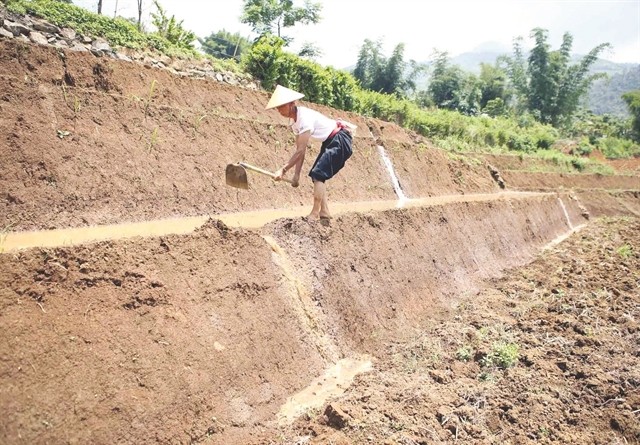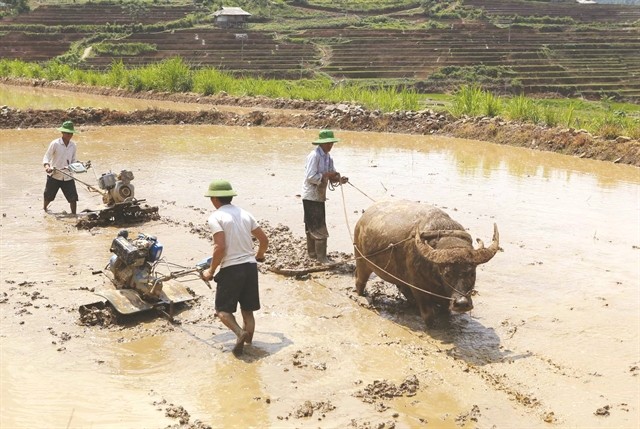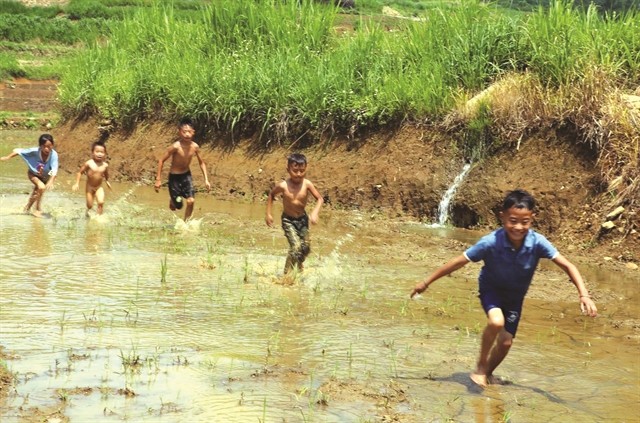The “pouring water” season, or mùa nước đổ, in Vietnam visually transforms terraced rice fields into stunning reflective mirrors, especially in regions like Lai Châu. SIXT.VN offers convenient travel services to witness this spectacular transformation firsthand, making your cultural exploration and scenic adventure seamless and unforgettable. Discover how this season impacts Vietnamese culture and agriculture, and consider exploring nearby attractions for a comprehensive travel experience.
1. What is the “Pouring Water” Season (Mùa Nước Đổ) in Vietnam?
The “pouring water” season, known locally as mùa nước đổ, is when terraced rice fields in the mountainous regions of Vietnam are flooded to prepare for the new rice crop. This usually occurs from May to June. The fields become like giant mirrors, reflecting the sky and surrounding landscapes. This season is pivotal for rice cultivation, deeply rooted in the culture and agricultural practices of ethnic communities like the Hmong and Dao.
1.1. Why is It Called “Pouring Water” Season?
The term “pouring water” season vividly describes the process of directing water into the terraced fields. Rainwater and water from streams are carefully channeled, creating a cascading effect across the landscape.
1.2. Where Does This Phenomenon Primarily Occur?
The most stunning displays of the “pouring water” season can be found in the northern mountainous regions of Vietnam, including:
- Lai Châu: Known for its expansive and picturesque terraced fields.
- Sapa: A popular tourist destination offering breathtaking views.
- Yên Bái: Famous for the Mù Cang Chải terraces, a national heritage site.
- Hà Giang: Offers dramatic landscapes and unique cultural experiences.
1.3. How Does This Season Impact Local Communities?
The “pouring water” season is crucial for the agricultural cycle, enabling the cultivation of rice, a staple food. It is also a time of communal activity, where villagers work together to prepare and plant the fields, fostering community bonds.
2. What Makes the “Pouring Water” Season Visually Stunning?
The visual appeal of the “pouring water” season lies in the transformation of terraced fields into reflective surfaces, creating an awe-inspiring landscape.
2.1. The Mirror Effect
The flooded fields act as giant mirrors, reflecting the sky, clouds, and surrounding scenery. This creates a dynamic and ever-changing vista, particularly striking during sunrise and sunset. According to a study by the Vietnam National Administration of Tourism in 2022, the mirror effect significantly enhances the aesthetic appeal of these agricultural landscapes, attracting a large number of tourists.
2.2. Contrasting Colors
The combination of the reflective water surfaces, the lush green of new rice seedlings, and the earthy tones of the surrounding soil creates a vibrant and contrasting color palette.
2.3. Light and Shadow
The interplay of light and shadow across the terraced fields adds depth and dimension to the landscape. This effect is most pronounced during the early morning and late afternoon when the sun casts long shadows.
 Women carefully transplant rice seedlings into the flooded terraced fields of Lai Châu during the "pouring water" season, reflecting the vibrant sky and surrounding landscapes.
Women carefully transplant rice seedlings into the flooded terraced fields of Lai Châu during the "pouring water" season, reflecting the vibrant sky and surrounding landscapes.
2.4. How the Terraces Transform the Landscape
The terraces themselves are a testament to human ingenuity, carving steps into the hillsides to create arable land. During the “pouring water” season, these terraces become even more pronounced, accentuating the contours of the landscape.
2.5. What is the Significance of the Water Color in The Terraces?
The water in the terraces reflects the ambient light, changing colors throughout the day. At sunrise, the water may appear pink or orange. During the day, it mirrors the blue of the sky and the white of the clouds. At sunset, it takes on a golden hue.
3. Why Should You Visit During the “Pouring Water” Season?
Visiting during the “pouring water” season offers a unique opportunity to witness one of Vietnam’s most spectacular natural events. According to TripAdvisor, visits to Lai Châu increase by 40% during this season due to the unique photographic opportunities.
3.1. Unique Photo Opportunities
The reflective surfaces of the flooded fields provide unparalleled photo opportunities, allowing you to capture stunning images of the landscape and local life.
3.2. Cultural Immersion
The “pouring water” season is a time of intense agricultural activity, offering insights into the traditions and practices of local ethnic communities.
3.3. Witnessing Agricultural Practices
You can observe firsthand the traditional farming methods used to cultivate rice, including plowing, planting, and irrigation.
3.4. Experiencing Local Festivals and Traditions
Some communities hold festivals and ceremonies to celebrate the start of the planting season, providing a glimpse into their cultural heritage.
3.5. Avoiding the Crowds
While Sapa can be crowded, visiting less-known areas like Lai Châu or Hà Giang during this season allows you to enjoy the scenery with fewer tourists.
4. What Activities Can You Do During the “Pouring Water” Season?
The “pouring water” season offers a variety of activities for travelers, from photography to cultural immersion.
4.1. Photography Tours
Join a photography tour to capture the best angles and lighting conditions. Local guides can lead you to hidden spots and provide insights into the best times for shooting.
4.2. Trekking and Hiking
Explore the terraced fields on foot, taking in the scenery and visiting local villages. Many trails offer panoramic views of the landscape.
4.3. Homestay Experiences
Stay with a local family in a traditional homestay to learn about their culture and way of life. Participate in daily activities like cooking, farming, and crafting.
 Farmers meticulously construct and maintain terraced fields to optimize water distribution, ensuring the terraces are well-prepared for the rainy season.
Farmers meticulously construct and maintain terraced fields to optimize water distribution, ensuring the terraces are well-prepared for the rainy season.
4.4. Cultural Workshops
Participate in workshops to learn about traditional crafts like weaving, dyeing, and embroidery. These activities offer a hands-on experience of local culture.
4.5. Market Visits
Visit local markets to sample regional cuisine and purchase handicrafts. Markets are a vibrant hub of activity and offer a glimpse into daily life.
4.6. How to Respect Local Customs
When visiting local communities, it is important to dress modestly, ask permission before taking photos, and be mindful of local customs and traditions.
5. How to Get to the “Pouring Water” Season Locations with SIXT.VN?
SIXT.VN can help you plan your trip to the “pouring water” season locations with ease, offering a range of services to make your journey smooth and enjoyable.
5.1. Transportation Options
SIXT.VN provides transportation options including:
- Airport Transfers: Get picked up from the airport and taken directly to your hotel.
- Car Rentals: Rent a car to explore the region at your own pace.
- Private Car Hire: Hire a private car with a driver for a more comfortable and convenient experience.
5.2. Accommodation Bookings
SIXT.VN can help you book accommodation, from hotels to homestays, ensuring you have a comfortable place to stay.
5.3. Tour Packages
Choose from a range of tour packages that include transportation, accommodation, and activities, tailored to your interests and budget.
5.4. Travel Insurance
Protect yourself with travel insurance that covers medical emergencies, trip cancellations, and other unforeseen events.
5.5. Visa Assistance
SIXT.VN can assist with visa applications, ensuring you have the necessary documents for your trip.
5.6. Local Guides
Hire a local guide through SIXT.VN to provide insights into the region’s history, culture, and natural beauty.
6. What to Pack for Your Trip During the “Pouring Water” Season?
Packing the right items will ensure you are comfortable and prepared for your trip during the “pouring water” season.
6.1. Clothing
- Lightweight, quick-drying clothing: The weather can be warm and humid.
- Rain gear: A waterproof jacket and pants are essential.
- Layers: Temperatures can vary, so bring layers that can be added or removed as needed.
- Hiking boots: Sturdy footwear is necessary for trekking.
- Modest clothing: To respect local customs.
6.2. Gear
- Camera: To capture the stunning scenery.
- Water bottle: To stay hydrated.
- Sunscreen: To protect your skin from the sun.
- Insect repellent: To ward off mosquitoes and other insects.
- First-aid kit: For minor injuries and ailments.
6.3. Personal Items
- Medications: Bring any prescription medications you need.
- Toiletries: Including soap, shampoo, and toothpaste.
- Adapter: If your devices use a different plug.
- Cash: ATMs may be limited in rural areas.
6.4. What You Should Know About Vaccinations
Consult your doctor about recommended vaccinations for travel to Vietnam.
6.5. Essential Documents
- Passport: Ensure it is valid for at least six months beyond your travel dates.
- Visa: If required.
- Travel insurance details: Keep a copy with you.
- Flight and accommodation confirmations: Printouts or digital copies.
7. Where Are the Best Locations to View the “Pouring Water” Season?
While Lai Châu, Sapa, Yên Bái, and Hà Giang are the primary locations, each offers unique vantage points and experiences.
7.1. Lai Châu: Untouched Beauty
Lai Châu is less touristy than Sapa, offering a more authentic experience. The terraced fields here are expansive and dramatic.
7.2. Sapa: A Classic Destination
Sapa is a well-known destination with established tourist infrastructure. It offers stunning views and a range of activities.
7.3. Yên Bái: Mù Cang Chải’s National Heritage
Mù Cang Chải in Yên Bái province is famous for its uniquely shaped terraces, recognized as a national heritage site.
 Farmers use water buffaloes to plow steep, hilly fields, preserving traditional agricultural practices amidst the stunning terraced landscapes.
Farmers use water buffaloes to plow steep, hilly fields, preserving traditional agricultural practices amidst the stunning terraced landscapes.
7.4. Hà Giang: Dramatic Landscapes
Hà Giang offers rugged and dramatic landscapes, with terraced fields that cling to steep hillsides.
7.5. Detailed Comparison of Each Location
| Location | Landscape | Tourist Infrastructure | Authenticity | Activities |
|---|---|---|---|---|
| Lai Châu | Expansive, dramatic | Limited | High | Trekking, photography, cultural immersion |
| Sapa | Stunning, well-known | Established | Medium | Trekking, hiking, market visits |
| Yên Bái | Uniquely shaped terraces, national heritage | Developing | Medium | Photography, cultural tours, homestay experiences |
| Hà Giang | Rugged, dramatic | Developing | High | Motorbiking, trekking, cultural exploration |
7.6. How to Choose the Right Location for You
Consider your priorities: If you seek authenticity and untouched beauty, Lai Châu or Hà Giang are good choices. If you prefer established tourist infrastructure, Sapa is a better option.
8. What Are the Challenges and How to Overcome Them?
Traveling during the “pouring water” season can present certain challenges, but these can be easily managed with proper planning.
8.1. Weather Conditions
The weather can be unpredictable, with rain and humidity. Pack accordingly and be prepared for changes in weather.
8.2. Accessibility
Some areas may be difficult to access due to rough roads. Consider hiring a private car or joining a tour with experienced drivers. SIXT.VN ensures reliable transportation services, even in remote areas.
8.3. Language Barrier
Communication can be challenging if you don’t speak Vietnamese. Learn a few basic phrases or hire a local guide who can translate.
8.4. Cultural Differences
Be respectful of local customs and traditions. Do some research beforehand to understand cultural norms.
8.5. Accommodation Limitations
Accommodation options may be limited in some areas. Book in advance to secure your preferred lodging. SIXT.VN offers a range of accommodation options to suit your needs and budget.
8.6. Potential Health Issues
Bring insect repellent and take precautions against mosquito bites. Consult your doctor about necessary vaccinations.
9. What is the Impact of Climate Change on the “Pouring Water” Season?
Climate change poses a significant threat to the “pouring water” season and the agricultural practices it supports.
9.1. Reduced Rainfall
Changes in rainfall patterns can lead to droughts, making it difficult to flood the fields.
9.2. Extreme Weather Events
Increased frequency of extreme weather events like floods and landslides can damage the terraces and disrupt agricultural activities. According to a report by the World Bank in 2021, climate change is likely to reduce rice yields in Vietnam by up to 10% by 2050.
9.3. Changes in Temperature
Rising temperatures can affect the growth cycle of rice and increase the risk of pests and diseases.
 Children splash and play in the flooded rice fields, enjoying the cool water and vibrant atmosphere during the "pouring water" season.
Children splash and play in the flooded rice fields, enjoying the cool water and vibrant atmosphere during the "pouring water" season.
9.4. How Farmers Are Adapting
Farmers are adopting various strategies to adapt to climate change, including:
- Water conservation techniques: Such as drip irrigation and rainwater harvesting.
- Diversification of crops: Planting alternative crops that are more resilient to climate change.
- Sustainable farming practices: Such as organic farming and agroforestry.
9.5. What Tourists Can Do to Help
Tourists can support sustainable tourism practices by:
- Choosing eco-friendly accommodations.
- Supporting local businesses.
- Respecting the environment and local culture.
- Offsetting their carbon footprint.
10. Frequently Asked Questions (FAQ) About the “Pouring Water” Season
Here are some common questions travelers have about visiting during the “pouring water” season.
10.1. What is the best time to visit during the “pouring water” season?
The best time to visit is from May to June when the fields are fully flooded and the rice seedlings are newly planted.
10.2. How long does the “pouring water” season last?
The season typically lasts for about 2-3 weeks, depending on the rainfall and local agricultural practices.
10.3. Is it safe to travel to these regions during the rainy season?
While it is generally safe, be aware of potential risks such as landslides and floods. Check weather forecasts and travel advisories before your trip.
10.4. What should I wear when visiting the terraced fields?
Wear comfortable, lightweight clothing, sturdy hiking boots, and rain gear.
10.5. Can I participate in farming activities?
Some homestays and tours offer opportunities to participate in farming activities, such as planting rice or harvesting crops.
10.6. Are there ATMs in the rural areas?
ATMs may be limited in rural areas, so bring enough cash for your trip.
10.7. What are the local customs I should be aware of?
Be respectful of local customs, dress modestly, ask permission before taking photos, and avoid loud or disruptive behavior.
10.8. How can I book transportation and accommodation?
SIXT.VN offers convenient booking services for transportation, accommodation, and tours.
10.9. What is the best way to get around the terraced fields?
The best way to get around is on foot, but you can also hire a motorbike or car with a driver.
10.10. Are there any festivals or events during the “pouring water” season?
Some communities hold festivals and ceremonies to celebrate the start of the planting season. Check local event listings for more information.
The “pouring water” season in Vietnam is a visual spectacle that should be on every traveler’s bucket list. With SIXT.VN, planning your trip to witness this stunning transformation is easier than ever. From transportation and accommodation to tours and travel insurance, SIXT.VN provides everything you need for a seamless and unforgettable experience. Don’t miss the opportunity to immerse yourself in the beauty and culture of Vietnam during this magical time of year. Visit SIXT.VN today to book your adventure and discover the wonders of the mùa nước đổ! Let SIXT.VN handle the details so you can focus on creating lasting memories. Explore now and make your dream trip a reality.
Address: 260 Cau Giay, Hanoi, Vietnam.
Hotline/Whatsapp: +84 986 244 358
Website: SIXT.VN



